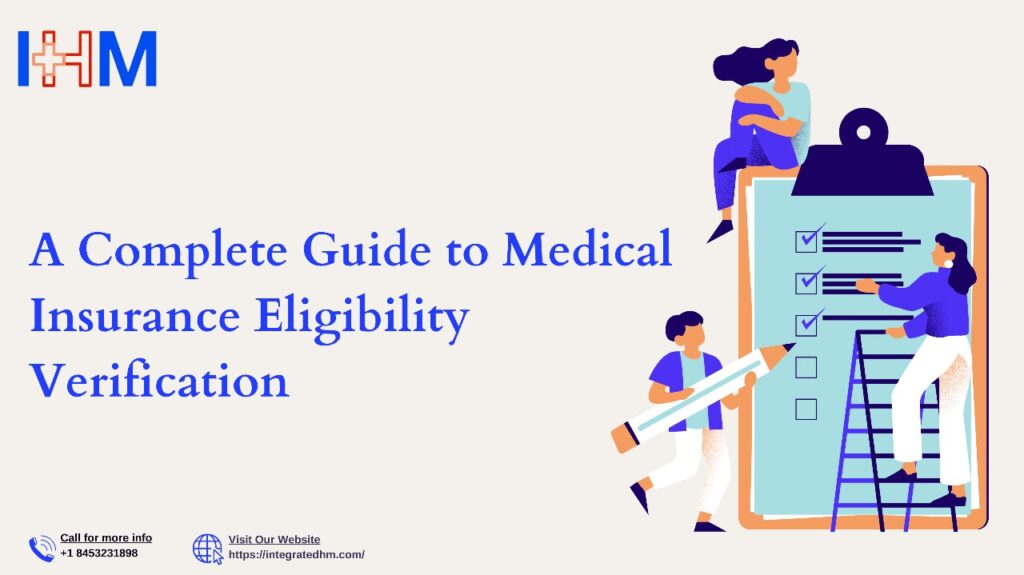Introduction
Medical insurance eligibility verification performs a pivotal function within the healthcare enterprise, making sure that sufferers receive the important scientific services without unexpected economic burdens. In this complete guide, we will discover the importance of medical health insurance eligibility verification, its methods, demanding situations, and the way both healthcare providers and patients can navigate this critical component of healthcare.
Why is Medical Insurance Eligibility Verification Important?
- Ensuring Patient Coverage: One of the number one purposes of medical insurance eligibility verification is to verify that sufferers are protected for the offerings they receive. This safeguards patients from surprising expenses.
- Preventing Claim Denials: Proper verification helps save you from declaring denials that can result in behind schedule bills or economic strain for each sufferer and healthcare companies.
- Identifying and Addressing Coverage Gaps: Verification helps pick out any gaps in a patient’s coverage. Healthcare carriers can then work with patients to address these gaps, probably avoiding troubles down the road.
- Protecting Providers from Losses: It’s critical for healthcare companies to verify insurance to keep away from financial losses. Unpaid or underpaid claims may have a big effect on a company’s revenue.
Who is Responsible for Medical Insurance Eligibility Verification?
The duty for medical insurance eligibility verification typically falls on healthcare providers. They are responsible for filing claims to coverage groups and ensuring they get hold of right compensation. However, a few sufferers pick out to verify their insurance insurance independently, mainly earlier than predominant tactics.
How is Medical Insurance Eligibility Verification Performed?
Medical insurance eligibility verification can be conducted manually or electronically:
- Manual Verification: Healthcare companies can manually verify insurance eligibility via contacting the affected person’s insurance agency and providing the important statistics.
- Electronic Verification: Many providers now use Electronic Eligibility Verification (EEV) systems, permitting a fast and green verification process. These structures electronically publish affected person statistics to coverage agencies for verification.
What Information is Needed to Verify Medical Insurance Eligibility?
The following statistics is normally required for the verification process:
- Patient’s call and date of beginning
- Patient’s insurance policy variety
- Patient’s coverage institution number
- Name of the insurance employer
- Type of coverage plan
Steps inside the Medical Insurance Eligibility Verification Process
Patient Registration: During patient registration, a healthcare company group of workers acquire the important insurance records.
- Insurance Verification: The staff verify coverage eligibility and the use of the chosen method.
- Pre-Authorization: If required by using the patient’s insurance plan, the workforce obtains pre-authorization earlier than turning in specific services.
- Service Delivery: After verification and, if necessary, pre-authorization, the healthcare company gives you the offerings to the patient.
- Claims Submission: Following carrier transport, the issuer submits a claim to the affected person’s insurance agency for payment.
Challenges Associated with Medical Insurance Eligibility Verification
Several demanding situations are related to this manner:
- Complexity of Insurance Plans: Insurance plans may be tricky, making it hard for healthcare vendors to live updated at the present day changes in insurance and advantages.
- Lack of Standardisation: The absence of a standardised layout for insurance eligibility records can complicate electronic verification.
- High Volume of Claims: The sizable wide variety of claims submitted yearly can result in delays in processing and price.
Improving the Verification Process
Healthcare companies can beautify their verification process through:
- Investing in Electronic Eligibility Verification (EEV) structures.
- Developing structures to keep song of coverage plan modifications.
- Collaborating with coverage companions to streamline the claims submission process.
Tips for Patients
Patients also can play a function in making sure correct and timely verification:
- Provide the most up-to-date coverage statistics to healthcare companies.
- Contact their coverage enterprise to confirm insurance earlier than main processes.
- Review Explanation of Benefits (EOB) statements cautiously to confirm that offerings acquired were covered and billed successfully.
Conclusion
Medical coverage eligibility verification is a crucial procedure that blesses each healthcare carrier and patients. It guarantees that patients acquire the care they want even as protecting them from sudden financial burdens. By understanding the significance of this method, each healthcare company and patient can paint together to navigate the complicated world of health insurance, leading to progressed healthcare studies and consequences.
FAQS
Q1: Why is health insurance eligibility verification vital for healthcare vendors?
Medical coverage eligibility verification is critical for healthcare carriers to make certain that they get hold of right compensation for the services they render. It allows them to confirm that sufferers are covered for the care they receive, preventing claim denials and monetary losses.
Q2: How can sufferers take part inside the medical insurance eligibility verification process?
Patients can actively take part by supplying accurate and up-to-date coverage facts to healthcare carriers in the course of registration. They can also contact their coverage organisation to verify coverage, specially before primary approaches. After receiving care, sufferers need to overview their Explanation of Benefits (EOB) statements cautiously to ensure accuracy.
Q3: What demanding situations do healthcare carriers face within the coverage verification system, and how can they enhance it?
Healthcare vendors often battle with the complexity of coverage plans, lack of standardisation in eligibility records, and an excessive volume of claims. To enhance the method, vendors can invest in Electronic Eligibility Verification (EEV) systems, establish mechanisms to live up to date on coverage plan modifications, and collaborate with insurance companions to streamline claims submission for greater green verification and reimbursement.

